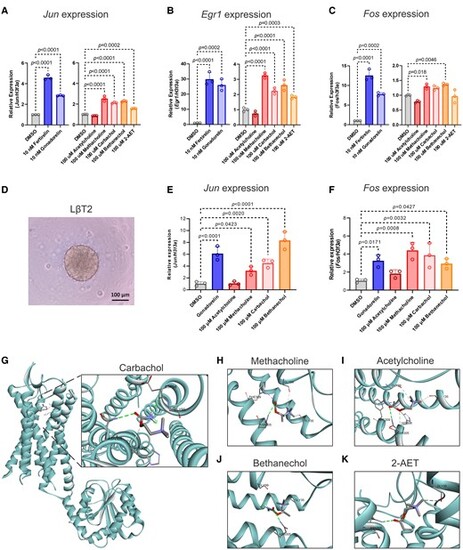Fig. 8
- ID
- ZDB-FIG-240912-40
- Publication
- Yang et al., 2024 - Identification of Environmental Compounds That May Trigger Early Female Puberty by Activating Human GnRHR and KISS1R
- Other Figures
- All Figure Page
- Back to All Figure Page
|
Methacholine-like cholinergic agonists stimulated gene expression in the downstream pathway of the Gonadotropin-releasing hormone receptor (GnRHR). Expression levels (via quantitative reverse-transcription polymerase chain reaction [qRT-PCR]) of A, Jun; B, Egr1; or C, Fos in murine pituitary cells after compound treatment for 2 hours. D, Morphology of LβT2 3-dimensional spheroids at 4 days before treatment. There was no change in morphology after treatment (data not shown). Expression levels (via qRT-PCR) of E, Jun, or F, Fos in murine pituitary LβT2 spheroids after compound treatment for 2 hours. G, Molecular docking studies predict the potential binding between carbachol and GnRHR. Docking energy: −4.2 kcal/mol. H, Molecular docking studies predict the potential binding sites between methacholine and the GnRHR. Docking energy: −4.7 kcal/mol. I, Molecular docking studies predict the potential binding between acetylcholine and GnRHR. Docking energy: −4.3 kcal/mol. J, Molecular docking studies predict the potential binding between bethanechol and GnRHR. Docking energy: −4.6 kcal/mol. K, Molecular docking studies predict the potential binding between (2-(acryloyloxy)ethyl)trimethylammonium (2-AET) and GnRHR. Docking energy: −4.6 kcal/mol. All values represent the mean ± SD (n = 3 replicates). Statistical analysis was performed using a one-way analysis of variance with Tukey multiple-comparison test, and the P value is shown in each graph. |

